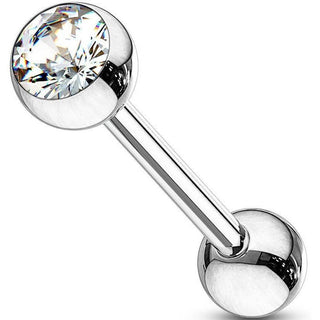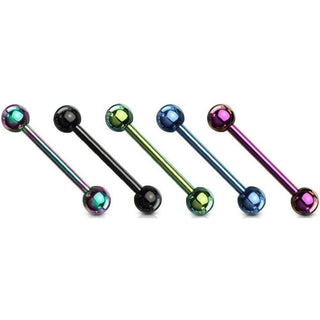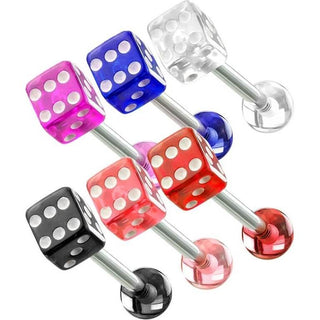Tongue Piercing
Discover our wide range of over 130 tongue piercings, crafted from high-quality materials like Titanium and 316L Surgical Steel. Enjoy competitive prices and exceptional customer service.
Zongepiercing
Zongepiercings gehéieren zu den ongewéinlechste Piercingaarten, déi duerch d'Zong gestach ginn a beim schwätzen ze gesinn sinn. Zongepiercings gesinn net nëmmen schéin aus, mee suergen och fir spannend Momenter, wat och zu hirer Popularitéit bäidréit. Gläichzäiteg kann dëse coole Kierperschmuck Schmuck d'Selbstvertraue vum Droen erhéijen. Eenzegaarteg Bijouen mat verschiddene Motiver wéi Blummen, Schiedel a Stären, ënner anerem, sinn fir dës Aart vu Piercing an eisem Shop disponibel. Eis filigran Zongepiercings mat glitzernden Zirkonia Piercing oder Opal Piercing Steng a verschiddene Faarwen a Faarfgradienten bidden Iech och e eleganten an spannenden Look.
Zongepiercings goufen an den 90er Jore besonnesch populär duerch d'Punk-Zeen a gehéieren nach haut zu de meescht gesichte Piercing-Trends. Wéinst hirem ongewéinlechen a gläichzäiteg diskreten Look ginn Zongepiercings vu ville Leit mat verschiddene Goûten gedroen. Egal ob virum oder no dem Piercing: Hei fannt Dir alles wat Dir iwwer Zongepiercing wësse musst, vu Piercingschmuck a Pfleeg bis hin zu de Risiken.
- Zongepiercing Typen - Zongepiercing Schmuck - Zongepiercing - Pfleeg an Heilung - Risiken
Zongepiercing Typen
Déi meescht Leit denken bei Zongepiercings un déi Aart vu Piercing, déi vertikal a zentral op der Zong gestach gëtt. Allerdéngs gehéieren zu den Zongepiercings vill verschidde Piercingaarten. Nieft der bekannteste Zort an der Mëtt vun der Zong ginn et och Zongepiercings, déi zum Beispill op der Säit oder ënner der Zong gestach ginn.
Net nëmmen d'Mëtt vun der Zong, mä och d'Spëtzt vun der Zong gëtt dacks vertikal gestach a kritt no der Heilung dacks e Rank oder e klengen Zongestécker. Am Géigesaz, bei der sougenannter Snake Eye Piercing, gëtt d'Spëtzt vun der Zong horizontal gestach. Déi zwou Kugelen un der Spëtzt sollen Aen vu Schlaangen ähnelen.
De Venom Piercing ass eng populär Zongepiercing-Aart, bei där d'Zong mat zwee vertikal gestachene a parallele Piercingstäck dekoréiert gëtt. De Scoop Piercing huet de selwechte Look wéi de Venom Bite, mä beim Scoop gëtt d'Zong horizontal gestach an duerno e Bananen Piercing agefouert. Béid Aarte vu Piercing kënnen, jee no Anatomie a Preferenz, weider vir oder méi wäit hannen positionéiert ginn.
De Zongenbändchen ass eng dënn Hautfalz ënner der Zong, déi d'Zong mam Mond verbënnt. Bei engem Zong Frenulum Piercing gëtt dës kleng Falz horizontal gestach an normalerweis mat enger klenger Banan, engem Zongepiercing Rank oder engem Hufeisen-Piercing verschéinert. Dës Variant ass am diskretesten, well de Frenulum-Piercing nëmmen ze gesinn ass, wann de Mond op ass an d'Zong eropgehuewen gëtt.
Zousätzlech kënnen Zongepiercing-Fans d'Zong mat e puer vun dësen Piercingaarten a verschiddene Kombinatiounen dekoréieren. Sou kritt d'Zong e eenzegaartege Look, deen d'Perséinlechkeet vum Droen reflektéiert.
Zongepiercing Schmuck
Fir Zongepiercings ginn am meeschte verbreet Barbell-Staark als Schmuck benotzt. D'Zongepiercing-Gréisst no der Heilung besteet normalerweis aus enger Längt vun ongeféier 16 mm an enger Staarkendick vun 1,6 mm. D'Kugelgréisst vun den Zongestécker ass normalerweis Goût- a Varietéitssach a läit tëscht ongeféier 5 mm an 7 mm. D'Gréisst vun der Kugel ënner der Zong ass normalerweis méi kleng wéi den iwwer der Zong sichtbaren Usaz. Mat eise Barbell-Sets kënnt Dir Zongepiercings a verschiddene Faarwen a Materialien zu engem gudde Präis ausprobéieren.
Nieft Barbell Piercing Staark ginn och Labrets vun der richteger Gréisst als Zonge-Schmuck benotzt. Dës bidden de Virdeel, datt se mat hirer flaacher Plack ënner der Zong net ze stéierend sinn. Eis héichwäerteg Titan Piercing Usätz mat faarwege Zirkonia Piercing a Opal Piercing Steng maachen et einfach, de Stil vum Labret Piercing z'änneren.
Piercing-Staark mat Réng, och Slave Barbells genannt, sinn e méi seelen Zonge-Schmuck a maachen de klassesche Zongepiercing mat hirem eenzegaartege Look zu engem Aenfang. Réng sinn och méiglech Bijouen fir lateral Zongepiercings souwéi fir d'Spëtzt vun der Zong. Den Duerchmiesser hänkt hei vun der Positioun vum Zongepiercing of.
Bananen Piercing ginn als Schmuck fir Snake Eyes benotzt. Dës sollten am léifsten aus engem flexiblen Material wéi PTFE oder Bioflex Piercing gemaach ginn, fir d'Mobilitéit vun der Zongspëtzt ze garantéieren.Päerdsféiss, Réng oder kleng Bananen ginn fir de Zongenbändchen benotzt. De Schmuck hei ass normalerweis besonnesch kleng, mat enger Staarkendick vun ongeféier 1,2 mm, fir dat dënnent Gewebe net ze beschiedegen oder souguer ze räissen. D'Usätz vun der Banan oder dem Päerdsféiss sinn och ganz kleng, ongeféier 2,5 - 3 mm.
Allgemeng sinn Bijouen aus mëlle Materialien wéi Plastik am beschte fir mëndlech Piercings no der Heilung gëeegent, well dat liicht Gewiicht de Tragekomfort erhéicht an de Risiko vu Schued un den Zänn miniméiert. Dëst ass well Kugelen aus Metaller wéi Titan oder Chirurgesche Stol Piercing vill méi haart sinn a sou d'Zänn oder Zännfleesch méi liicht beschiedegen kënnen. Wann Dir awer de Look vu Metallkugelen léiwer hutt, sollt Dir am Alldag sou virsiichteg wéi méiglech mat Ärem Kierperschmuck sinn.
D'Zongepiercing-Kugelen sinn den sichtbaren Deel vun dëser Aart vu Piercing. Aus dësem Grond bidden mir unzuelbar Variatioune vun Usätz un, vu coole Motiver mat z.B. Smileys a liewege Faarwen, glitzernde Kugelen bis hin zu einfachen an eleganten Metallkugelen. Egal ob diskret oder opfälleg: An eisem Shop fannt Dir de richtege Look fir all Stil.
Zongepiercing
Beim Stéche vun engem Zongepiercing gëtt de Mond als éischt mat Hëllef vun engem Mondspull oder Mondspray desinfizéiert an dacks och lokal betäubt. Nodeems de Beräich gebotzt gouf, gëtt d'Zong mat engem flauschefräie Stoff gedréchent, markéiert a mat Klemmzangen fixéiert. Dann ginn déi markéiert Punkten mat enger steriler Nadel gestach. Et ass besonnesch wichteg, datt keng Nerven oder Venen getraff ginn. Dofir sollt e Zongepiercing nëmmen vun engem erfuerene Piercer aus engem professionelle Studio gemaach ginn.
Well d'Zong an den éischten Deeg no dem Piercing staark schwellen kann, gëtt e méi laange Staark vun ongeféier 18 - 22 mm als éischte Schmuck agefouert. Dëst bitt méi Plaz fir d'Schwellung a verhënnert Komplikatioune wéi d'Versenkung vum Usatz. Nodeems d'Zong erëm erofgeschwollen ass, wäert de Piercer de Piercingstaark bei engem Kontrolltermin erëm verkierzen.
D'Schmäerz vun engem Zongepiercing hänkt vun Ärer eegener Péngwahrnehmung of a ass dofir fir all Persoun anescht. D'Aart vum Zongepiercing spillt och eng wichteg Roll. Wärend de klassesch Zongepiercing an der Mëtt vun der Zong allgemeng manner schmerzhaft ass, kënnen lateral Zongepiercings a Piercings duerch d'Zongspëtzt e bësse méi wéi. Dëst ass well et méi Nerven um Rand vun der Zong gëtt. Wann Dir grouss Angscht virum Péng hutt, kënnt Dir de Piercer no enger Betäubung froen.
D'Käschte vun engem Zongepiercing hänken vu verschiddene Faktoren of wéi Regioun, Studio an Aart vum Piercing. Am Allgemengen kënnt Dir erwaarden, bis zu 70€ fir e Zongepiercing ze bezuelen.
Pfleeg an Heilung
An den éischten 3 - 5 Deeg no dem Piercing schwëllt d'Zong dacks staark un a geet dann lues erof. Keng Panik, dës éischt Schwellung ass ganz normal a bei de meeschte mëndleche Piercings ze gesinn. D'Bildung vu klore Wonnesekret an Plooschteren ronderëm d'Piercingplaz ass och normal an den éischten Deeg. No ongeféier een bis zwou Wochen sollt d'Zong erëm komplett erofgeschwollen sinn. Hei kënnen kleng Äiswierfelen aus Kamillen Téi de Prozess beschleunegen an d'Onbequemlechkeet erliichteren. Vill Leit bemierken och eng onschéin wäiss Beschichtung op der Uewerfläch vun der Zong an den éischten Deeg. Dëst ass harmlos a verschwënnt normalerweis, nodeems de Zongepiercing geheelt ass.
D'korrekt Pfleeg vun engem Zongepiercing ass entscheedend fir eng glatte Heilung an den éischte Wochen. Nieft den üblechen Pfleegschrëtt ginn et och e puer Diätregelen ze befollegen, wann een e Zongepiercing huet. Wann Dir e Zongepiercing hutt, sollt Dir fir déi éischt zwou Wochen Mëllech a Mëllechprodukter vermeiden. Alkohol a Nikotin sollten och an dëser Zäit vermeide ginn. Zousätzlech sollten sauer Liewensmëttel wéi Zitrusfrüchte souwéi ze schaarf, waarm oder kal Iessen a Gedrénks vermeide ginn. Well Iessen a Kauen duerch déi geschwollene Zong erschwéiert ginn, sinn lauwarm Zoppen a Puppelcher déi bescht Liewensmëttel fir de Moment.
D'Benotzung vun enger mëller Zännbiischt an engem spezielle Mondspull zweemol am Dag ass och wichteg, fir d'Piercingwonn net ze reizen an eng séier Heilung ze förderen. Keen vun deenen zwou Produkter däerf Alkohol enthalen. De Mond sollt och no all Iessen ausgespullt ginn. Beim Rees kann e spezielle Piercing Mondspray fir d'Pfleeg no dem Iessen benotzt ginn. Zousätzlech sollt Kontakt mat auslännesche Kierperflëssegkeeten wéi Spaut och vermeide ginn, am léifsten während der ganzer Heilungsphase. Dementspriechend si Kuss a och Oralsex fir de Moment e No-Go.
Andeems Dir dës Regele befollegt, ass d'Heilungszäit op ongeféier 4 bis 8 Wochen limitéiert. Eng Ausnam ass de Zongenbändchen-Piercing, deen no nëmmen 2 bis 3 Wochen heelt.
Nodeems de Zongepiercing geheelt ass, ass et ganz wichteg, de Schmuck reegelméisseg ze botzen. Dëst ass well et unzuelbar Bakterien am Mondberäich gëtt, déi onschéinlech Verfärbungen a Ablagerungen um Zonge-Schmuck verursaache kënnen. Et ass genuch, de Piercing sanft mat enger Zännbiischt beim Zännputzen ze botzen an de Schmuck all zwee bis dräi Méint eraus ze huelen an grëndlech ze botzen.
Tipp: Fir eng besonnesch grëndlech Botzen kann de Zonge-Schmuck an eng Këscht mat Mondspull-Léisung geluecht ginn. En Ultraschallreiniger kann och hëllefen, de Schmuck bis an déi klengste Ecker ze botzen.
Beim Wiessel vum Zonge-Schmuck sollt Dir sou séier wéi méiglech virgoen, well d'Stéchkanäl vu Zongepiercings ganz séier zouwuesse kënnen. D'Lach kann bannent e puer Stonnen komplett zou sinn, dofir sollt de Piercingstaark nëmmen méi laang erausgeholl ginn, wann de Zongepiercing net méi gewënscht ass. Fir net beim Botzen a Wiessel ze presséieren, kann e Ersatzstaark an de Piercingkanal agefouert ginn. Dëst verhënnert, datt d'Lach onbewosst zouwuesst.
Risiken
Nieft dem ästheteschen Look huet och d'Piercing an d'Droen vun engem Zongepiercing Risiken, déi bei der Decisioun fir dëse Piercing berécksiichtegt solle ginn. Leit, déi scho Problemer mat hiren Zänn a Zännfleesch hunn, sollten dëse Piercing suergfälteg iwwerleeën. Och wann et e Risiko vun Infektioun bei Zongepiercings gëtt, ass en manner wéi bei anere Piercingaarten, well d'Schleimhäute a Spaut geschützt sinn. Trotzdem sollt Dir de frësche Piercing gutt fleegen, fir Entzündungen ze vermeiden.
Sproochfehler wéi Lispelen oder Murmelen sinn dacks direkt no dem Piercing méiglech. Mä dëst verschwënnt dacks mat der Zäit, nodeems Dir Iech un de Friemkierper an Ärem Mond gewinnt hutt. An dëser Zäit sollt Dir aktiv probéieren, sou kloer wéi méiglech ze schwätzen, fir séier erëm normal schwätzen ze kënnen. Wann Dir nach ëmmer Sproochproblemer hutt, nodeems de Piercing geheelt ass, kann et sinn, well de Piercingstaark ze laang ass oder d'Kugelen ze grouss sinn. An dësem Fall kann de Wiessel vum Zongestécker hëllefen.
D'Entwécklung vu Schued un den Zänn ass e seriöse Risiko bei Zongepiercings. Spillen mat dem Zonge-Schmuck kann mat der Zäit irreversibel Mikrorëss op den Zänn verursaachen. Den Email kann och duerch Reiwung mam Schmuck zréckgoen. Wann den Email fort ass, ginn d'Zänn méi schwaach a méi ufälleg fir Broch a Schued. Ausserdeem kann zoufälleg op d'Kugel beim Kauen bäissen och zu Schued un den Zänn féieren.
Fir dëse Schued un den Zänn ze vermeiden, ass eng disziplinéiert Befolgung vu e puer Regele ratsam. All Spillen mam Schmuck sollt sou vill wéi méiglech vermeide ginn. Dëst beinhalt souwuel d'Kugel géint d'Zänn ze klicken wéi och um Usatz ze saugen. Zousätzlech si reegelméisseg Zänndokterbesich héich recommandéiert, fir méiglech Schuede fréi ze erkennen. Wann tatsächlech Schued un den Zänn duerch de Zonge-Schmuck verursaacht gouf, ass seng direkt Ewechhuele fir d'Gesondheet vun den Zänn néideg.
Et gëtt vill Venen, Muskelen an Nerven op der Zong, déi beim Piercing net getraff däerfen ginn, fir datt de Piercing séier an ouni Problemer heele kann. E kompetente Piercer wäert de Mondberäich ganz suergfälteg ënnersichen an dës Plazen beim Piercing vermeiden. Dofir ass d'Recherche vun engem professionelle Studio am Viraus essentiell.
E Risiko ass d'Versenkung oder d'Awuessen vun der Kugel während dem Heilungsprozess. Äre Piercer wäert normalerweis déi richteg Längt vum éischte Schmuck wielen, fir dëst ze verhënneren. Wann d'Zong awer onerwaart sou vill schwëllt, datt d'Kugel verschwënnt, sollt de Piercer de Staark direkt duerch e méi laange ersetzen.
Eng Gefor, déi mat Zongepiercing assoziéiert soll sinn, ass de Verloscht vum Goûtssënn. Mä dëst ass selten de Fall, well d'Geschmaachsknospen laanscht de baussenzege Rand vun der Zong verdeelt sinn an dofir net mat de meeschte Zongepiercingaarten a Kontakt kommen. Sollt de Goûtssënn wierklech no engem Zongepiercing (z.B. Snake Eyes) reduzéiert sinn, ass dëst nëmmen temporär. Dëst ass well et Dausende vu Geschmaachsknospen op der Zong gëtt, déi sech erëm regeneréiere kënnen, wa se blesséiert ginn.









































